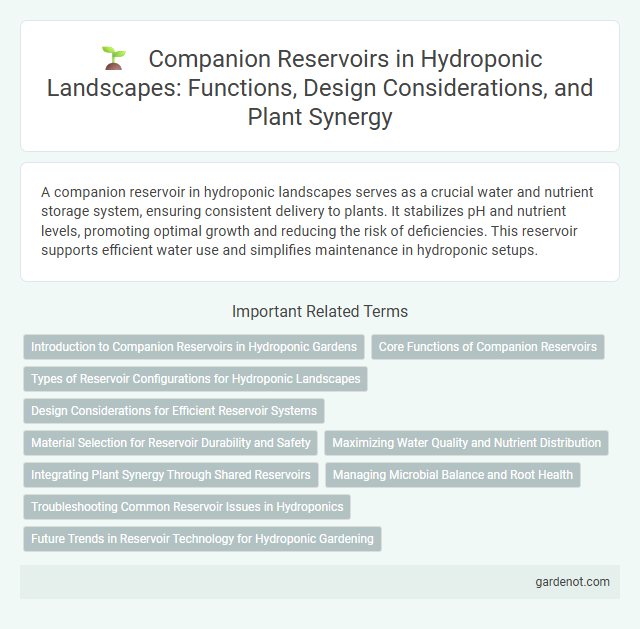A companion reservoir in hydroponic landscapes serves as a crucial water and nutrient storage system, ensuring consistent delivery to plants. It stabilizes pH and nutrient levels, promoting optimal growth and reducing the risk of deficiencies. This reservoir supports efficient water use and simplifies maintenance in hydroponic setups.
Introduction to Companion Reservoirs in Hydroponic Gardens
Companion reservoirs in hydroponic gardens serve as secondary water storage units that stabilize nutrient delivery and buffer pH fluctuations. These reservoirs facilitate efficient nutrient management by allowing growers to mix and test nutrient solutions separately before introducing them to the main system. Integrating companion reservoirs enhances system reliability and promotes healthier plant growth by maintaining consistent environmental conditions.
Core Functions of Companion Reservoirs
Companion reservoirs in hydroponic systems primarily regulate water supply and maintain nutrient balance by storing and distributing essential minerals directly to plant roots. These reservoirs ensure stable pH levels and dissolved oxygen concentrations, critical for optimal plant growth and root health in a controlled environment. By minimizing water loss and facilitating nutrient cycling, companion reservoirs enhance overall system efficiency and promote sustainable hydroponic cultivation.
Types of Reservoir Configurations for Hydroponic Landscapes
Companion reservoirs for hydroponic landscapes come in various configurations, including separate, integrated, and modular types. Separate reservoirs are standalone units connected via tubing, allowing easy maintenance without disrupting the planting area. Integrated reservoirs are built directly into the growing system, providing compact setups with minimal water loss, while modular reservoirs offer customizable volumes to match specific plant needs and system scalability.
Design Considerations for Efficient Reservoir Systems
Design considerations for efficient companion reservoirs in hydroponic landscapes include optimizing reservoir size to balance adequate nutrient solution volume with space constraints, ensuring proper material selection for durability and chemical resistance, and incorporating effective aeration systems to maintain oxygen levels for root health. Temperature control mechanisms should be integrated to prevent thermal stress on plants, while reservoirs must be designed for easy access to facilitate routine maintenance and prevent contamination. Strategic placement within the hydroponic system supports efficient nutrient circulation, minimizing energy consumption and promoting consistent growth.
Material Selection for Reservoir Durability and Safety
Selecting high-density polyethylene (HDPE) for companion reservoirs ensures excellent durability and resistance to UV radiation, preventing degradation in hydroponic landscapes. Food-grade materials with non-toxic properties are critical to safeguard water quality and plant health, minimizing contamination risks. Reinforced reservoir designs incorporating corrosion-resistant coatings and impact-resistant plastics further extend longevity and maintain structural integrity under environmental stress.
Maximizing Water Quality and Nutrient Distribution
A companion reservoir in hydroponic systems enhances water quality by providing a stable environment for nutrient solution storage and circulation, minimizing microbial growth and sedimentation. It ensures uniform nutrient distribution to plant roots through continuous mixing and aeration, optimizing plant uptake and growth. Regular monitoring of pH, electrical conductivity (EC), and dissolved oxygen levels in the reservoir maximizes system efficiency and crop yield.
Integrating Plant Synergy Through Shared Reservoirs
Companion reservoirs in hydroponic landscapes enable multiple plant species to share a common nutrient solution, promoting symbiotic interactions and optimizing resource use. This integration enhances nutrient uptake efficiency and stabilizes pH levels, fostering healthier growth and increased yields. Shared reservoirs also simplify maintenance and reduce water consumption, aligning with sustainable horticultural practices.
Managing Microbial Balance and Root Health
Companion reservoirs in hydroponic landscapes play a crucial role in managing microbial balance by promoting beneficial microbes that suppress pathogens and enhance nutrient availability. Maintaining optimal oxygen levels and consistent water circulation within the reservoir supports robust root health and prevents harmful biofilm buildup. Regular monitoring and adjustment of pH and nutrient concentrations ensure a stable environment, fostering a thriving root zone essential for plant growth.
Troubleshooting Common Reservoir Issues in Hydroponics
Troubleshooting common reservoir issues in hydroponics involves monitoring pH levels, nutrient concentration, and temperature to prevent plant stress and root diseases. Algae growth and sediment buildup can be controlled by using opaque reservoirs and regular cleaning protocols. Ensuring proper aeration and preventing leaks maintain optimal oxygen levels and water circulation for healthy plant development.
Future Trends in Reservoir Technology for Hydroponic Gardening
Emerging trends in companion reservoir technology for hydroponic gardening include smart sensors and IoT integration, enabling real-time monitoring of nutrient levels, pH, and water temperature to optimize plant growth. Advanced materials with antimicrobial properties are being developed to reduce biofilm formation and extend reservoir lifespan. Automated nutrient dosing systems powered by AI algorithms are enhancing precision and efficiency in hydroponic nutrient management.
Companion reservoir Infographic

 gardenot.com
gardenot.com